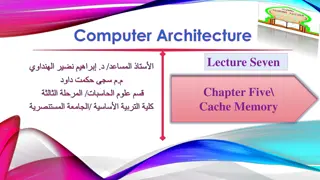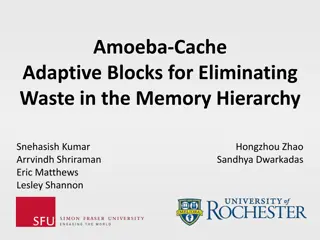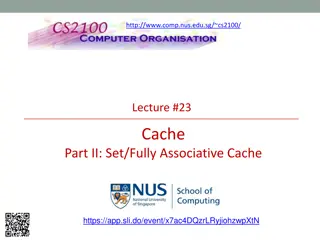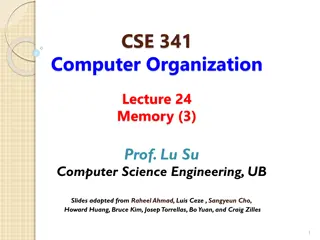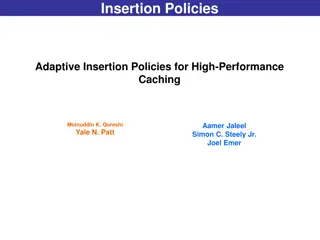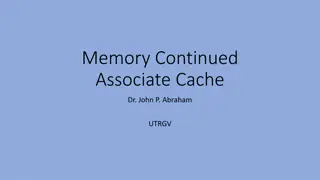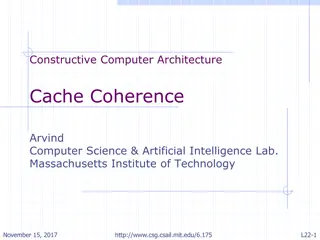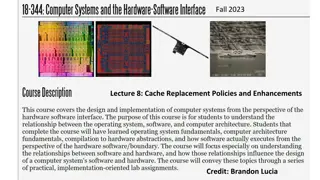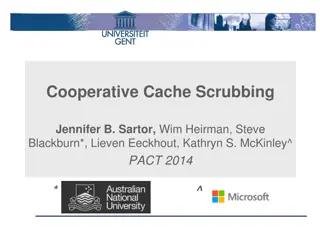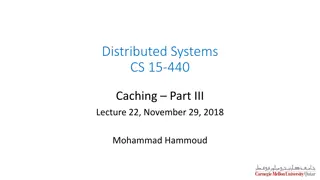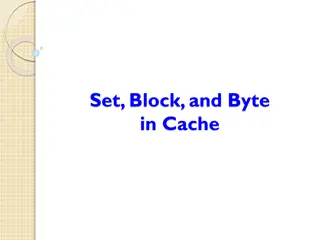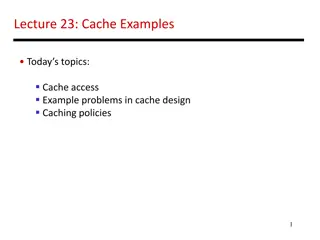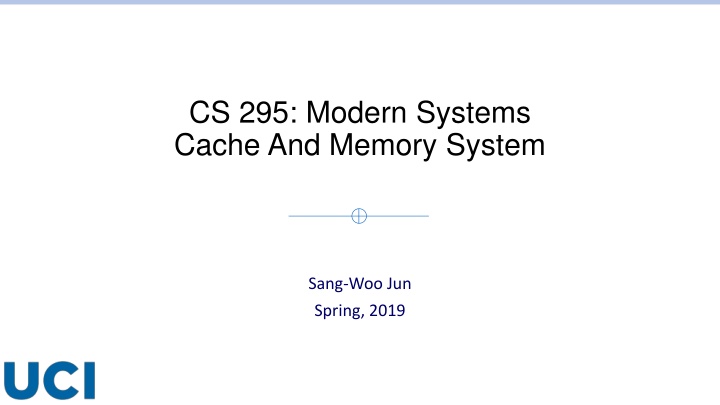
Modern Cache and Memory Systems: Insights and Trends
Explore the evolution of cache and memory systems, from historical processors to modern CPUs like Intel Coffee Lake. Discover the intricacies of cache architecture, memory system bandwidth, and the importance of efficient cache line management for optimal performance in contemporary computing environments.
Download Presentation

Please find below an Image/Link to download the presentation.
The content on the website is provided AS IS for your information and personal use only. It may not be sold, licensed, or shared on other websites without obtaining consent from the author. If you encounter any issues during the download, it is possible that the publisher has removed the file from their server.
You are allowed to download the files provided on this website for personal or commercial use, subject to the condition that they are used lawfully. All files are the property of their respective owners.
The content on the website is provided AS IS for your information and personal use only. It may not be sold, licensed, or shared on other websites without obtaining consent from the author.
E N D
Presentation Transcript
CS 295: Modern Systems Cache And Memory System Sang-Woo Jun Spring, 2019
Watch Video! CPU Caches and Why You Care Scott Meyers o His books are great!
Some History 80386 (1985) : Last Intel desktop CPU with no on-chip cache (Optional on-board cache chip though!) 80486 (1989) : 4 KB on-chip cache Coffee Lake (2017) : 64 KiB L1 Per core 256 KiB L2 Per core Up to 2 MiB L3 Per core (Shared) What is the Y-axis? Most likely normalized latency reciprocal Source: Extreme tech, How L1 and L2 CPU Caches Work, and Why They re an Essential Part of Modern Chips, 2018
Memory System Architecture Package Package Core Core Core Core L1 I$ L1 D$ L1 I$ L1 D$ L1 I$ L1 D$ L1 I$ L1 D$ L2 $ L2 $ L2 $ L2 $ L3 $ L3 $ QPI / UPI DRAM DRAM
Memory System Bandwidth Snapshot Cache Bandwidth Estimate 64 Bytes/Cycle ~= 200 GB/s/Core Core Core DDR4 2666 MHz 128 GB/s QPI / UPI Ultra Path Interconnect Unidirectional 20.8 GB/s DRAM DRAM Memory/PCIe controller used to be on a separate North bridge chip, now integrated on-die All sorts of things are now on-die! Even network controllers! (Specialization!)
Cache Architecture Details Numbers from modern Xeon processors (Broadwell Kaby lake) Core Core Cache Level Size Latency (Cycles) L1 I$ L1 D$ L1 I$ L1 D$ L1 64 KiB < 5 L2 256 KiB < 20 L2 $ L2 $ L3 ~ 2 MiB per core < 50 > 100* L3 $ DRAM 100s of GB L1 cache is typically divided into separate instruction and data cache Each with 32 KiB L1 cache accesses can be hidden in the pipeline o All others take a performance hit * DRAM subsystems are complicated entities themselves, and latency/bandwidth of the same module varies by situation
Cache Lines Recap Caches are managed in Cache Line granularity o Typically 64 Bytes for modern CPUs o 64 Bytes == 16 4-byte integers Reading/Writing happens in cache line granularity o Read one byte not in cache -> Read all 64 bytes from memory o Write one byte -> Eventually write all 64 bytes to memory o Inefficient cache access patterns really hurt performance!
Cache Line Effects Example Multiplying two 2048 x 2048 matrices o 16 MiB, doesn t fit in any cache Machine: Intel i5-7400 @ 3.00GHz Time to transpose B is also counted A A BT B VS 10.39 seconds (6x performance!) 63.19 seconds
Cache Prefetching CPU speculatively prefetches cache lines o While CPU is working on the loaded 64 bytes, 64 more bytes are being loaded Hardware prefetcher is usually not very complex/smart o Sequential prefetching (N lines forward or backwards) o Strided prefetching Programmer-provided prefetch hints o __builtin_prefetch(address, r/w, temporal_locality); for GCC
Cache Coherence Recap We won t go into architectural details Simply put: o When a core writes a cache line o All other instances of that cache line needs to be invalidated Emphasis on cache line
Issue #1: Capacity Considerations: Matrix Multiply Performance is best when working set fits into cache o But as shown, even 2048 x 2048 doesn t fit in cache o -> 2048 * 2048 * 2048 elements read from memory for matrix B Solution: Divide and conquer! Blocked matrix multiply o For block size 32 32 -> 2048 * 2048 * (2048/32) reads BT A C A1 B1 C1 B2 = B3 C1 sub-matrix = A1 B1 + A1 B2 + A1 B3
Blocked Matrix Multiply Evaluations Benchmark Elapsed (s) Normalized Performance Na ve 63.19 1 Transposed 10.39 6.08 Blocked Transposed 7.35 8.60 Bottlenecked by computations AVX Transposed 2.20 28.72 Bottlenecked by memory Bottlenecked by computation Blocked AVX Transposed 1.50 42.13 8 Thread AVX Transposed AVX Transposed reading from DRAM at 14.55 GB/s o 20483 * 4 (Bytes) / 2.20 (s) = 14.55 GB/s o 1x DDR4 2400 MHz on machine -> 18.75 GB/s peak o Pretty close! Considering DRAM also used for other things (OS, etc) Multithreaded getting 32 GB/s effective bandwidth o Cache effects with small chunks 1.09 57.97 Bottlenecked by memory (Not scaling!)
Issue #2: False Sharing Different memory locations, written to by different cores, mapped to same cache line o Core 1 performing results[0]++; o Core 2 performing results[1]++; Remember cache coherence o Every time a cache is written to, all other instances need to be invalidated! o results variable is ping-ponged across cache coherence every time o Bad when it happens on-chip, terrible over processor interconnect (QPI/UPI) Remember the case in the Scott Meyers video
Issue #3 Instruction Cache Effects Instruction cache misses can effect performance o Linux was routing packets at ~30Mbps [wired], and wireless at ~20. Windows CE was crawling at barely 12Mbps wired and 6Mbps wireless. [ ] After we changed the routing algorithm to be more cache-local, we started doing 35MBps [wired], and 25MBps wireless 20% better than Linux. Sergey Solyanik, Microsoft o [By organizing function calls in a cache-friendly way, we] achieved a 34% reduction in instruction cache misses and a 5% improvement in overall performance. -- Mircea Livadariu and Amir Kleen, Freescale
Improving Instruction Cache Locality #1 Unfortunately, not much we can do explicitly We can Careful with loop unrolling and inlining o They reduce branching overhead, but reduces effective I$ size o When gcc s O3 performs slower than O2, this is usually what s happening o Inlining is typically good for very small* functions Move conditionals to front as much as possible o Long paths of no branches good fit with instruction cache/prefetcher
Improving Instruction Cache Locality #2 Organize function calls to create temporal locality Sequential algorithm Ordering changed for cache locality Balance to reduce memory footprint Livadariu et. al., Optimizing for instruction caches, EETimes
https://frankdenneman.nl/2016/07/11/numa-deep-dive-part-3-cache- coherency/





